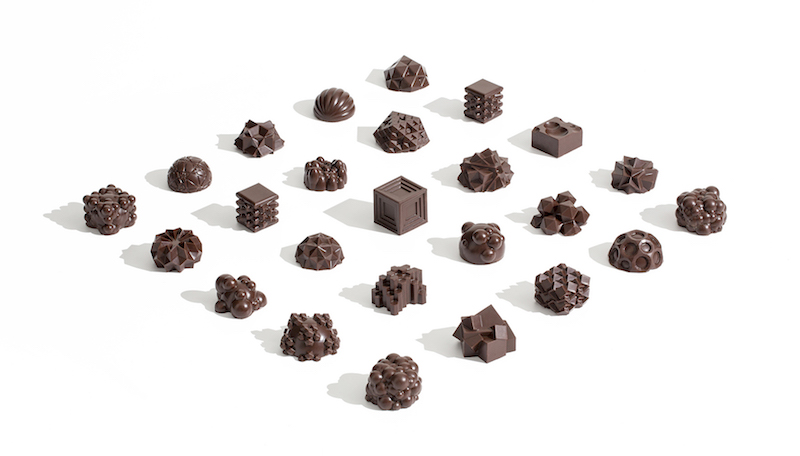In ‘Application of 3D Printing in Meat Production,’ researchers delve further into the possibilities of additive manufacturing with food. While there have been some forays into 3D fabrication with meat, most viable production of food has related more to extrusion of sweets, breads, and items more conducive to being expressed through a nozzle. The authors point out that some of the greatest benefits in 3D printing can be translated to use with food as so many consumers today have special dietary needs—and 3D printing technology allows for complete customization, even with the possibility of adding specific vitamins to food, along with flavors and different structures.
Food customization is certainly nothing new, as chefs around the world have been creating special dishes for eons; however, ‘artisans’ today are often challenged in creating one-of-a-kind dishes as such an exercise can be cost-prohibitive.
“Digital gastronomy brings in cooking knowledge into food fabrication so that our eating experience can go beyond merely taste and cover all the aspects of gastronomy,” state the researchers.
So many different health conditions can be addressed too, and especially for individuals who may have trouble eating, chewing, or swallowing their food. The research team explains that the greatest potential for customized food lies in 3D printing techniques such as:
- Extrusion
- Inkjet printing
- Binding deposition
- Bioprinting
Their number one choice for creating food, however, is a natural one, with extrusion:
“The syringe-based extrusion unit is suitable to print food materials with high viscosity and high mechanical strength, to fabricate complex 3D structures with high resolution. The air pressure-based extrusion and syringe-based extrusion do not allow the continuous feeding of food materials during printing. The viscosity of the soft material should be both low enough to be easily extruded through a fine nozzle, and high enough to hold the subsequently deposited layers,” stated the researchers.
Significant challenges are still present, however, regarding precision in fabrication, performance in processing, and issues with flavor, structure, and ‘binding mechanisms.’ So far, most processing of meat in 3D printing has been in a slurry form, which makes sense for extrusion; however, this may not be conducive to presenting a gourmet product by any stretch. The addition of other binding components, however, like gelatin, should improve meat processing.
Techniques such as electrospinning may also be beneficial, resulting in meat that is the desired shape and size, created of strong micro-fibers. Electrospinning can also be more conducive to good flavor due to the fibrous advantage. Microencapsulation is another technique that could be useful as it compresses vitamins and minerals and oils together, feasibly with a multi-print head system.
“For a better understanding of its printability, as well as the 3DP settings and post-processing conditions of the printed product is required to optimize formulation through the rheological and mechanical properties for beef paste. Further research may be conducted with beef materials in order to improve its nutrutional value and sensorial profile by means of addition of bioactive ingredients and including complex internal structures, respectively,” concluded the researchers.
“Applying new technologies to 3D food printing like electrospinning and encapsulation can help improving 3D printed meat products and become a potential way to fabricate on demand products.”

Other companies such as Oceanz and Cooperative Door are experimenting with creating 3D printed veggies via recycled food waste (Photo: ‘Oceanz and Cooperative DOOR Partner to Stop Food Waste with 3D Printed Vegetables‘)
3D printing and food are one of the most tantalizing subjects, and while the fabrication of meat is certainly an interesting concept, researchers over the past few years have also brought 3D printed chocolate, pancakes, a variety of savory items, and so much more to our attention. Ultimately, consumers should have much more control over how their food is processed and made at home, as well as in restaurants, and many institutional settings.
What do you think of this news? Let us know your thoughts! Join the discussion of this and other 3D printing topics at 3DPrintBoard.com.

3D printed chocolate is extremely popular among enthusiasts (photo: Artist Ryan L. Foote, in ‘These 3D Printed Chocolates Are Inspired By Natural Wonders and Exotic Locales‘)
Subscribe to Our Email Newsletter
Stay up-to-date on all the latest news from the 3D printing industry and receive information and offers from third party vendors.
You May Also Like
Further Understanding of 3D Printing Design at ADDITIV Design World
ADDITIV is back once again! This time, the virtual platform for additive manufacturing will be holding the first-ever edition of ADDITIV Design World on May 23rd from 9:00 AM –...
3D Printer Maker EVO-tech Reborn as NEVO3D — Once More With Feeling
EVO-tech was a 3D printing service and original equipment manufacturer established in 2013 and based in Schörfling am Attersee, Austria. The company produced high-quality material extrusion systems featuring linear bearings,...
3D Systems Brings 3D Printed PEEK Cranial Implant to the U.S. with FDA Clearance
For more than 10 years, 3D Systems (NYSE:DDD) has worked hand-in-hand with surgeons to plan over 150,000 patient-specific cases, and develop more than two million instruments and implants from its...
CDFAM Returns to Berlin for Second Annual Symposium
The second CDFAM Computational Design Symposium is scheduled for May 7-8, 2024, in Berlin, and will convene leading experts in computational design across all scales. Building upon the first event...
































